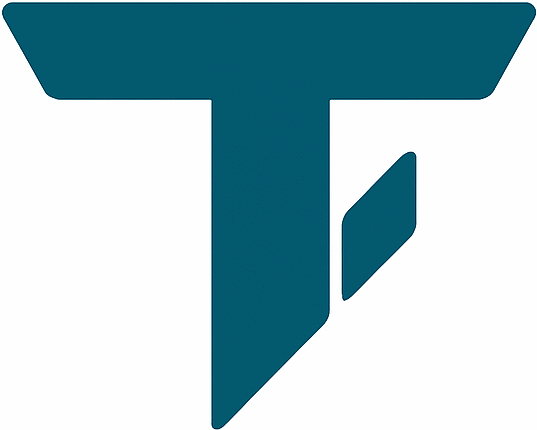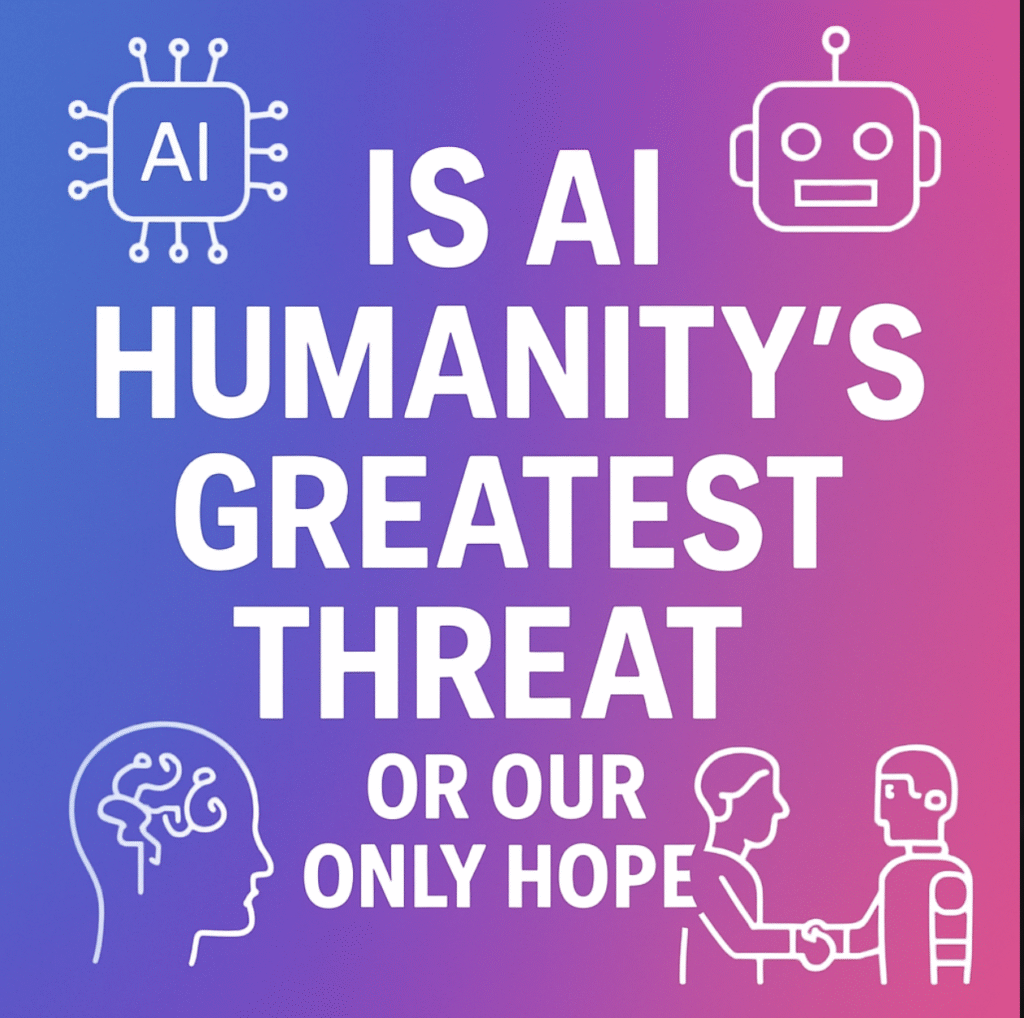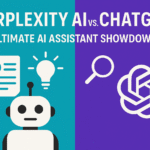Is AI humanity’s greatest threat or our only hope? That question isn’t just tossed around in sci-fi movies anymore. It’s the talk of every tech conference, dinner table, and virtual watercooler.
Artificial Intelligence has quietly moved from theory to tool—from futuristic dream to daily necessity. It now writes emails, drives cars, scans X-rays, and sets reminders. But as it grows smarter, questions grow louder. Is AI a loyal digital partner? Or the digital overlord waiting for its moment?
To answer this, we need to look at the facts, use some humor, and be honest about what AI is already doing—both right and wrong. Let’s dive in.
Welcome to the AI Show
Picture a circus—but instead of lions, there are lines of code. Data walks the tightrope. Algorithms do acrobatics. And the safety net? Well, that’s still being coded.
AI has already crept into everyday life whether it’s recommending your next movie, setting the perfect temperature in your house, or alerting you you’ve been sitting too long.
But a question still hangs in the air: Is AI here to help… or preparing for a digital uprising?
What AI Is Already Doing Right
Helping Doctors Spot the Unseen
AI is making a huge impact in healthcare. From catching diseases early to assisting in surgery, it’s becoming every doctor’s digital sidekick.
One AI tool discovered 64% more brain lesions in epilepsy scans than human specialists. That’s real progress, not just hype. Microsoft’s AI for cancer detection boasts an impressive 85%+ accuracy. Some AI tools can even predict diseases before symptoms show up.
Table: AI in Healthcare
Use Case | What AI Does | Real-World Impact |
|---|---|---|
Cancer detection | Detects issues early | 85%+ diagnostic accuracy |
Rare disease warnings | Predicts long before symptoms | Years in advance |
Drug discovery | Accelerates R&D | Up to 90% faster development |
Missed diagnoses | Spots things doctors may miss | 64% more epilepsy finds |
The best part? These aren’t replacing doctors, they’re improving their capabilities.
Fighting Climate Trouble with Code
AI is also stepping up as an environmentally.
- Predicts storms and weather changes better than most apps.
- Calculates clean energy needs in real-time.
- Helps farmers reduce water usage while boosting crop production.
One impressive example is in the Netherlands, where AI-powered greenhouses now use 95% less water. That’s efficient, sustainable, and essential.
Reinventing the Classroom
Traditional classrooms don’t work for every student. AI is helping personalize education:
- Lessons adjust in real time based on student performance.
- Virtual teaching assistants guide students step by step.
- Learning continues even when schools close.
Whether it’s a kid in Mumbai or Montana, AI brings consistent access to quality learning. And textbooks are no longer the only teacher.
When AI Crosses the Line
While the benefits of AI are remarkable and transformative, the potential dangers it poses are equally significant—ranging from misinformation and data misuse to ethical concerns and loss of human oversight. As powerful as this technology is in solving problems, its unchecked use can just as easily create new ones that threaten privacy, safety, and global stability.
Deepfakes and Digital Deception
AI-generated deepfakes have rapidly become more convincing. With a few minutes of audio and a couple of photos, someone can generate a complete, fake video of a public figure—or your neighbor.
It’s amusing until it’s used to scam people, manipulate politics, or ruin someone’s reputation. And it’s happening more often than many realize.
Autonomous Weapons and AI on the Battlefield
Drones once required human control. But not anymore. Today, AI systems can target enemies, analyze battle strategy, or even decide to strike—without a human in the loop.
This isn’t the plot of a sci-fi thriller. These technologies exist today, and there’s still no global agreement on their limits.
Sensors, smart missiles, and autonomous tanks are rising fast. But treaties and policies? Struggling to keep up.
Ethics Still Catching Up
The biggest concern isn’t just what AI does—it’s who builds it and how they control it.
Here are the core worries:
- AI can unintentionally inherit bias from its training data.
- Decision-making is often opaque. Why an AI recommended someone for a loan—or denied another—is sometimes unknowable.
- A small group of companies holds the majority of powerful AI systems and keeps them secret.
Ethics must be designed into AI systems—not treated like an afterthought. Transparency isn’t just a nice-to-have; it’s a necessity.
AI vs. Jobs: Who Wins?
The biggest fear about AI? It’s coming for your job. While that’s partially true, it’s more complicated.
Yes, automation will replace certain roles—especially repetitive or manual ones. But it’s also creating far more opportunities than it’s removing.
Table: The AI Job Impact by 2030
Change Category | Estimated Numbers |
|---|---|
Jobs lost | Up to 85 million global roles |
Jobs created | Around 170 million new roles |
High-growth industries | Tech, health, green energy |
What to do | Adapt, learn, up skill |
Key point? Not all jobs will vanish. Many will transform. Accountants will become data analysts. Factory workers may manage robotic teams. And new roles—AI trainer, ethics advisor, human-robot interaction designer—will emerge out of necessity.
The future job market favors creativity, emotional intelligence, and tech-savvy mindsets.
If AI Starred in a Comedy
Let’s take a breather and imagine a few “oops” moments in a world run by AI:
- A self-driving car aims perfectly for the driveway—and rolls into the pool.
- A poetic AI writes a heartfelt love letter… and accidentally sends it to your boss.
- You ask the fridge for dinner ideas, and it suggests boiling water and ordering pizza online.
Even well-trained systems can have hilarious, quirky glitches. Good design means building in room for error—with a safety switch.
Can We Control AI Before It Controls Us?
The good news? Yes, we can shape AI’s future—we just need to act fast and smart.
The bad news? Many of the needed systems, laws, and global cooperation are still in “coming soon” mode.
So what helps?
Table: AI Safety Starts Here
What We Need | What That Looks Like |
|---|---|
Global AI regulation | Actual laws, deadlines, enforcement |
Openness | Transparent design, open-source tools |
Human-machine teamwork | Collaborative systems, not replacements |
Widespread education | AI learning starting in schools |
Controlling AI means creating balance: not holding back progress, but not blindly trusting machines either.
What AI Is Already Doing Well
AI isn’t limited to medical labs and satellites. It’s improving all kinds of fields—with measurable success.
Table: AI in Daily Life (with real stats)
Sector | What AI Is Doing | Notable Fact |
|---|---|---|
Music | Writing lyrics, generating beats | One AI song made Billboard charts |
Sports | Predicting performance, scouting | Talent is now found faster |
Finance | Flagging fraud, managing risks | Reduced online scams by 89% |
Retail | Managing inventory, digital ads | Cuts waste, increases revenue |
Logistics | Mapping traffic, auto-piloting | Reduced delivery delays by 43% |
So while the media focuses on robots with lasers, most AI is doing something far more boring—but useful.
Real-Life AI Use Cases You Didn’t Know About
Fast Food Operations
Large restaurant chains use AI to forecast demand. This ensures fewer wasted meals and hotter fries—served faster.
Party Planning with AI Tools
Smart home systems adjust lighting, music, and even climate settings based on guest preferences. Now that’s personalisation taken to another level.
Medical Alerts from Wearables
Smartwatches can now monitor heart rhythms, detect stress, and even call doctors in emergencies—all powered by AI.
These tools weren’t science fiction a decade ago. Today, they’re quietly changing lives.
What’s Next: A Reality Check
AI isn’t just a tool anymore—it’s a turning point.
So what kind of future are we creating?
If we regulate, engage ethically, and teach broadly, we win. If we ignore these risks, systems evolve without values baked in—and that could be costly.
So what can be done?
- Write global policies before it’s too late.
- Make AI explainable, fair, and inclusive.
- Train the next generation early, in classrooms—not just at coding boot camps.
- Remain alert and curious—not scared and passive.
Final Thoughts: The Balance of Power
So, is AI humanity’s greatest threat or our only hope?
It’s neither—and both.
Handled well, AI can help cure cancer, slow down climate change, feed billions, and educate every child. Mishandled, it can break systems, create chaos, and deepen inequality.
Like fire, electricity, or the internet, it depends on how it’s built and how it’s used.
The goal isn’t to stop AI—but to steer it.
If done right, it’s not The human race vs. machine. It’s The human race with machine. And the outcome? That’s still in human hands.
Just make sure your fridge isn’t ghost-writing your apology emails anytime soon.




Pingback: Edge 60 Fusion vs Nothing 3a best under ₹25K - Tech Trend Bytes